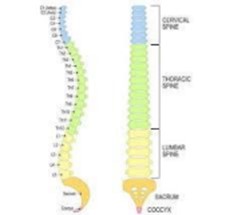When classifying spinal cord injuries, which of the following does the nurse understand is an example of the level of injury?
Quadriplegia
Incomplete loss of function
CA injury
Hyperextension
The Correct Answer is C
Choice A Rationale: Quadriplegia is a type of paralysis that affects all four limbs and the trunk, usually caused by an injury to the cervical spine (C1-C8).
Choice B Rationale: Incomplete loss of function refers to the extent of injury and whether some neurological function remains, not the level of injury.
Choice C Rationale: CA injury refers to cervical spine injury, which is the most common level of spinal cord injury.
Choice D Rationale: Hyperextension, like other mechanisms of injury (such as compression, flexion, or flexion-rotation), can contribute to spinal cord injury but does not define the level of injury.

Nursing Test Bank
Naxlex Comprehensive Predictor Exams
Related Questions
Correct Answer is C
Explanation
Choice A Rationale: Repositioning may be important for preventing complications, but it does not explain the pain described by the client.
Choice B Rationale: A continual inflammatory process is not typically the cause of the pain described by the client with a spinal cord injury.
Choice C Rationale: Nerve damage in the spinal cord is a common cause of neuropathic pain with these characteristics.
Choice D Rationale: Telling the client that the pain will go away in 2 weeks without further assessment or explanation is not accurate and may raise unrealistic expectations.
Correct Answer is ["B","E"]
Explanation
Choice A Rationale: Tetanus does not affect only the spinal cord; it is a systemic bacterial infection that affects the nervous system and muscles.
Choice B Rationale: Manifestations of tetanus can include sustained muscle contractions, which result in muscle stiffness and spasms.
Choice C Rationale: Tetanus is not caused by a recent viral infection; it is caused by the bacterium Clostridium tetani.
Choice D Rationale: While tetanus can result from contaminated wounds, it is not typically associated with improperly processed foods. It is caused by the spores of the Clostridium tetani bacterium.
Choice E Rationale: Tetanus spores are commonly found in soil, gardens, and manure. Contaminated wounds, especially puncture wounds, are a common route of transmission for the spores.
Whether you are a student looking to ace your exams or a practicing nurse seeking to enhance your expertise , our nursing education contents will empower you with the confidence and competence to make a difference in the lives of patients and become a respected leader in the healthcare field.
Visit Naxlex, invest in your future and unlock endless possibilities with our unparalleled nursing education contents today
Report Wrong Answer on the Current Question
Do you disagree with the answer? If yes, what is your expected answer? Explain.
Kindly be descriptive with the issue you are facing.
